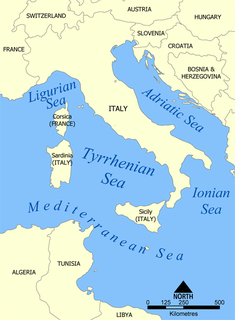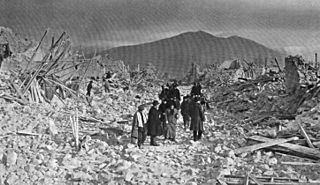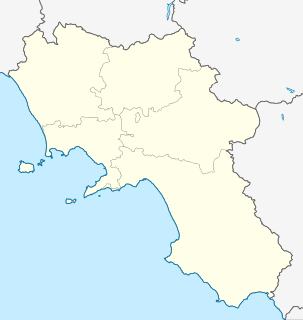 W
WThis is a list of earthquakes in Italy.
 W
WThe AD 62 Pompeii earthquake occurred on 5 February AD 62. It had an estimated magnitude of between 5 and 6 and a maximum intensity of IX or X on the Mercalli intensity scale. The towns of Pompeii and Herculaneum were severely damaged. The earthquake may have been a precursor to the eruption of Mount Vesuvius in AD 79, which destroyed the same two towns. The contemporary philosopher and dramatist Seneca the Younger wrote an account of the earthquake in the sixth book of his Naturales quaestiones, entitled De Terrae Motu.
 W
WAn earthquake, rated at VII on the Mercalli intensity scale, struck northern Italy and Germany on 3 January 1117. The epicentre of the first shock was near Verona, the city which suffered the most damage. The outer wall of the amphitheatre was partially felled, and the standing portion was damaged in a later earthquake of 1183. Many other churches, monasteries, and ancient monuments were destroyed or seriously damaged, eliminating much of Verona's early medieval architecture and providing space for a massive Romanesque rebuilding. After the first shock of 3 January, seismic activity persisted for months, striking on 12 January, 4 June, 1 July, 1 October, and 30 December.
 W
WThe 1169 Sicily earthquake occurred on 4 February 1169 at 08:00 local time on the eve of the feast of St. Agatha of Sicily. It had an estimated magnitude of between 6.4 and 7.3 and an estimated maximum perceived intensity of X (Extreme) on the Mercalli intensity scale. Catania, Lentini and Modica were severely damaged. It triggered a tsunami. Overall, the earthquake is estimated to have caused the deaths of at least 15,000 people.
 W
WThe 1222 Brescia earthquake occurred on Christmas Day in the year 1222. The chronicler Salimbene de Adam records that it was so powerful that the inhabitants of Brescia left their city en masse and camped outside, so that the falling buildings would not crush them.
 W
WThe 1343 earthquake struck the Tyrrhenian Sea and Bay of Naples on November 25, 1343. Underground shocks were felt in Naples and caused significant damage and loss of lives. Of major note was a tsunami created by the earthquake which destroyed many ships in Naples and destroyed many ports along the Amalfi Coast including Amalfi itself. The effects of the tsunami were observed by the poet Petrarch, whose ship was forced to return to port, and recorded in the fifth book of his Epistolae familiares.
 W
WThe 1348 Friuli earthquake, centered in the South Alpine region of Friuli, was felt across Europe on 25 January. The quake hit in the same year that the Great Plague ravaged Italy. According to contemporary sources, it caused considerable damage to structures; churches and houses collapsed, villages were destroyed and foul odors emanated from the earth.
 W
WOn 9 September 1349, an earthquake sequence began in Italy's Apennine Mountains that severely affected the Molise-Latium-Abruzzi regions. Four moderate-large earthquakes devastated towns and villages across the central Italian peninsula, with damage even reported in Rome. These earthquakes originated from the Apennine fold and thrust belt fault network, with the first and most destructive shock's epicenter originating from the north-west Campania region. Paleoseimological data gathered from scarping, fault length, and collapsed sections of Venafro's Roman aqueduct indicates the epicenter of the main shock was likely along the Aquae Iuliae fault. The fault suspected of causing this earthquake occurred on the Aqua Iuliae fault along the Molise-Campania border.
 W
WThe 1570 Ferrara earthquake struck the Italian city of Ferrara on November 16 and 17, 1570. After the initial shocks, a sequence of aftershocks continued for four years, with over 2000 in the period from November 1570 to February 1571.
 W
WThe 1626 Girifalco earthquake occurred on April 5 at 12:45. It was the strongest earthquake in a sequence that lasted from March 27 through to October of that year. It had an estimated magnitude of 6.0 Me and a maximum perceived intensity of X (extreme) on the Modified Mercalli scale. It caused widespread destruction in Girifalco and Catanzaro, then part of the Kingdom of Naples. There is no precise estimate for the number of casualties, but it is thought to lie in the range 11-100. The earthquake may have been caused by movement on the NW-SE trending Stalettì-Squillace-Maida fault system.
 W
WThe 1627 Gargano earthquake struck Gargano, southern Italy, at about mid-day on 30 July 1627. A "very large earthquake" caused a major tsunami, the largest seismic event ever recorded in the Gargano region, which "produced severe damage in the whole promontory", killing about 5000 people. Four aftershocks were documented. The most extensive damage was noted between San Severo and Lesina.
 W
WThe 1639 Amatrice earthquake occurred on 7 October near Amatrice, in the upper valley of the river Tronto, at the time part of the Kingdom of Naples, now Italy.
 W
WThe 1688 Sannio earthquake occurred in the late afternoon of June 5 in the province of Benevento of southern Italy. The moment magnitude is estimated at 7, with a Mercalli intensity of XI. It severely damaged numerous towns in a vast area, completely destroying Cerreto Sannita and Guardia Sanframondi. The exact number of victims is unknown, and is estimated at about 10,000. It is among the most destructive earthquakes in the history of Italy.
 W
WThe 1693 Sicily earthquake struck parts of southern Italy near Sicily, Calabria, and Malta on January 11 at around 21:00 local time. This earthquake was preceded by a damaging foreshock on January 9. The main quake had an estimated magnitude of 7.4 on the moment magnitude scale, the most powerful in Italian recorded history, and a maximum intensity of XI (Extreme) on the Mercalli intensity scale, destroying at least 70 towns and cities, seriously affecting an area of 5,600 square kilometres (2,200 sq mi) and causing the death of about 60,000 people.
 W
WThe 1694 Irpinia–Basilicata earthquake occurred on 8 September. It caused widespread damage in the Basilicata and Apulia regions of what was then the Kingdom of Naples, resulting in more than 6,000 casualties. The earthquake occurred at 11:40 UTC and lasted between 30 and 60 seconds.
 W
WThe 1703 Apennine earthquakes were a sequence of three earthquakes of magnitude ≥6 that occurred in the central Apennines of Italy, over a period of 19 days. The epicenters were near Norcia, Montereale and L'Aquila, showing a southwards progression over about 36 km. These events involved all of the known active faults between Norcia and L'Aquila. A total of about 10,000 people are estimated to have died as a result of these earthquakes, although because of the overlap in areas affected by the three events, casualty numbers remain highly uncertain.
 W
WThe 1732 Irpinia earthquake was a seismic event with a magnitude of 6.6 that affected Irpinia and part of Sannio. It occurred on 29 November 1732 at 8:40 AM local time (UTC+1). The epicenter was located in the Campanian Apennines, in the area of the Ufita Valley, which is part of the modern-day Province of Avellino. Around twenty populated areas were destroyed entirely or in part and tens of others were significantly damaged. The number of deaths was estimated to be 1,940. Damage from the earthquake was classified as "severe", and the number of homes destroyed as classified as "many". The earthquake had a rating on the modified Mercalli intensity scale of X (extreme).
 W
WThe 1783 Calabrian earthquakes were a sequence of five strong earthquakes that hit the region of Calabria in southern Italy, the first two of which produced significant tsunamis. The epicenters form a clear alignment extending nearly 100 km from the Straits of Messina to about 18 km SSW of Catanzaro. The epicenter of the first earthquake occurred in the plain of Palmi. The earthquakes occurred over a period of nearly two months, all with estimated magnitudes of 5.9 or greater. Estimates of the total number of deaths lie in the range 32,000 to 50,000.
 W
WThe 1805 Molise earthquake occurred on July 26 at 21:01 UTC. It has an estimated magnitude of 6.6 on the equivalent magnitude scale (Me) and a maximum perceived intensity of X on the Mercalli intensity scale. The area of greatest damage was between the towns of Isernia and Campobasso, while the area of intense damage extended over about 2,000 square kilometres. There were an estimated 5,573 deaths resulting from this earthquake and two of the aftershocks.
 W
WThe 1857 Basilicata earthquake occurred on December 16 in the Basilicata region of Italy southeast of the city of Naples. The epicentre was in Montemurro, on the western border of the modern province of Potenza. Several towns were destroyed, and estimated fatalities were around 10,000. At the time it was the third largest known earthquake, and has been estimated to have been of magnitude 7.0 on the moment magnitude scale.
 W
WThe 1873 Alpago earthquake occurred near the Italian city of Belluno on June 29 in the geologically active Alpago Valley of the Veneto region; the zone is rated as two on a four-degree risk scale. The 6.3 magnitude quake was rated as IX–X (Violent–Extreme) on the Mercalli intensity scale. Intensities greater than VII were confined to the provinces of Belluno, Treviso and Pordenone.
 W
WStriking southern Italy on September 8, the 1905 Calabria earthquake had a moment magnitude of 7.9 and a maximum Mercalli intensity of XI (Extreme). The first major earthquake of the 20th century, it severely damaged parts of Lipari, Messina Province and a large area between Cosenza and Nicotera and killed between 557 and 2,500 people.
 W
WOn October 23, 1907, a magnitude 5.9 earthquake struck Calabria, at a depth of 33.0 km. in the area of Gerace-Siderno, on the southeast coast of Calabria. The event caused 167 deaths and major damage.
 W
WThe 1908 Messina earthquake occurred on 28 December in Sicily and Calabria, southern Italy with a moment magnitude of 7.1 and a maximum Mercalli intensity of XI (Extreme). The cities of Messina and Reggio Calabria were almost completely destroyed and between 75,000 and 82,000 lives were lost. It was the most destructive earthquake ever to strike Europe.
 W
WThe 1915 Avezzano earthquake or 1915 Fucino earthquake occurred on 13 January in central Italy at 07:52:42 local time. The shock had a moment magnitude of 6.7 and a maximum Mercalli intensity of XI (Extreme). The epicenter was located in the town of Avezzano in the Province of L'Aquila. Around 30,000 direct fatalities and $60 million in damage resulted from the earthquake.
 W
WThe 1920 Garfagnana earthquake occurred on September 7 in Garfagnana and Lunigiana, both agricultural areas in the Italian Tuscany region. The quake hypocenter was located 14 kilometres (8.7 mi) beneath Villa Collemandina. The maximum felt intensity was rated as X (Extreme) on the Mercalli intensity scale, and 6.6 on the Richter magnitude scale. It was one of the most destructive seismic events recorded in the Apenninic region in the twentieth century. Due to good news coverage, availability of official documents on the damage and abundance of recordings from surveillance stations throughout Europe, it was regarded as a first-rate case study to improve knowledge of tectonics and macroseismic analysis.
 W
WThe 1930 Irpinia earthquake occurred at 00:08 UTC on 23 July, chiefly in an area known as Irpinia. It had a surface wave magnitude of 6.6 and a maximum intensity of X . The event caused 1,404 deaths and 4,624–7,000 injuries. The epicenter was near the boundaries between the regions of Basilicata, Apulia, and Campania.
 W
WThe 1930 Senigallia earthquake struck the city of Senigallia in central Italy on October 30. It occurred just a few months after the destructive 1930 Irpinia earthquake, which had caused over 1400 casualties in the southern part of the country.
 W
WThe 1936 Cansiglio earthquake occurred on October 18 in the region between the provinces of Belluno, Treviso and Pordenone, in northern Italy. It caused 19 deaths and an unknown number of injuries.
 W
WThe 1968 Belice earthquake sequence took place in Sicily between 14 and 15 January. The largest shock measured 5.5 on the moment magnitude scale, with five others of magnitude 5+. The maximum perceived intensity was X (Extreme) on the Mercalli intensity scale. The earthquake sequence, centred between the towns of Gibellina, Salaparuta and Poggioreale, killed at least 231 people, possibly more than 400, with between 632 and about 1,000 injured and left 100,000 homeless. It is known in Italy as Terremoto del Belice.
 W
WThe 1976 Friuli earthquake, also known in Italy as Terremoto del Friuli, took place on May 6 with a moment magnitude of 6.5 and a maximum Mercalli intensity of X (Extreme). The shock occurred in the Friuli region in northeast Italy near the town of Gemona del Friuli. 990 people were killed, up to about 3,000 were injured, and more than 157,000 were left homeless.
 W
WThe 1980 Irpinia earthquake took place in Southern Italy on November 23 with a moment magnitude of 6.9 and a maximum Mercalli intensity of X (Extreme). The shock was centered on the village of Conza and left at least 2,483 people dead, at least 7,700 injured, and 250,000 homeless.
 W
WThe 1997 Umbria and Marche earthquake occurred in the regions of Umbria and Marche, central Italy on the morning of September 26. It was preceded by a foreshock almost as strong as the main quake. The foreshock occurred at 02:33 CEST, rated Mw5.7, and the second – the main shock – occurred at 11:40 CEST, rated Mw 6.0. Their epicentre was in Annifo.
 W
WThe 2009 L'Aquila earthquake occurred in the region of Abruzzo, in central Italy. The main shock occurred at 03:32 CEST on 6 April 2009, and was rated 5.8 or 5.9 on the Richter magnitude scale and 6.3 on the moment magnitude scale; its epicentre was near L'Aquila, the capital of Abruzzo, which together with surrounding villages suffered the most damage. There have been several thousand foreshocks and aftershocks since December 2008, more than thirty of which had a Richter magnitude greater than 3.5.
 W
WIn May 2012, two major earthquakes struck Northern Italy, causing 27 deaths and widespread damage.
 W
WThe 2017 Ischia earthquake occurred in the island of Ischia, Campania, in southern Italy. The main shock occurred at 20:57 CEST on 21 August 2017, and was rated 3.9 on the Moment magnitude scale.
 W
WThe 2018 Molise earthquake hit the Italian regions of Molise on 15 August at 19:15:00 (UTC).
 W
WAn earthquake, measuring 6.2 ± 0.016 on the moment magnitude scale, hit Central Italy on 24 August 2016 at 03:36:32 CEST.
 W
WA series of four major earthquakes struck Central Italy between Abruzzo, Lazio, the Marche and Umbria regions on 18 January 2017.
 W
WThe 2002 Molise earthquakes hit the Italian regions of Molise and Apulia on 31 October at 10:32:58 (UTC) and 1 November at 15:09:00 (UTC). The shocks had magnitudes of 5.9 and 5.8 Mw respectively. Most of the victims were killed and injured when a school collapsed in the town of San Giuliano di Puglia: 26 of the 51 schoolchildren died, together with one of their teachers. In particular, none of the nine children in the school's 4th Year survived.
 W
WA series of major earthquakes struck Central Italy between the Marche and Umbria regions in October 2016. The third quake on 30 October was the largest in Italy in 36 years, since the 1980 Irpinia earthquake.